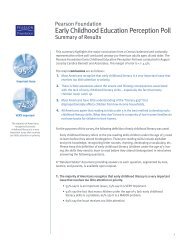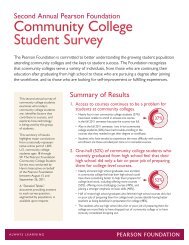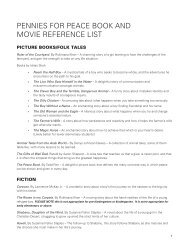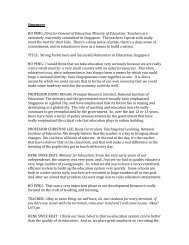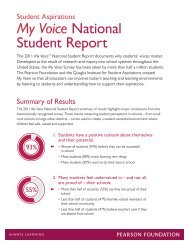The Technology Factor: Nine Keys to Student Achievement and Cost ...
The Technology Factor: Nine Keys to Student Achievement and Cost ...
The Technology Factor: Nine Keys to Student Achievement and Cost ...
Create successful ePaper yourself
Turn your PDF publications into a flip-book with our unique Google optimized e-Paper software.
14 Chapter 3: Major Findings<br />
Copying <strong>and</strong> paperwork expenses. Project RED estimates that 1:1<br />
high schools with a properly implemented Learning Management<br />
System (LMS) could cut their copy budgets in half. Labor accounts for<br />
roughly 50% of the <strong>to</strong>tal cost. Assuming the cost of a copy machine is<br />
$100,000 per year for a 1,500-student high school, on a national basis<br />
this equates <strong>to</strong> savings of $739 million a year for high schools alone.<br />
Instructional materials. �e use of instructional materials can be tied<br />
<strong>to</strong> student performance over large sample sizes, so that educa<strong>to</strong>rs can<br />
identify what works for which populations <strong>and</strong> deploy the most<br />
effective materials on a student-by-student basis.<br />
Dropout rate. One broad financial impact of technology is a reduction<br />
in dropout rates. �e huge economic cost of dropouts is well known, 3<br />
but 1:1 schools are cutting the dropout rate <strong>and</strong> impacting state<br />
revenues as well as local costs.<br />
�e greatest financial benefit results from the difference in lifetime tax<br />
revenues between a dropout, a high school graduate, <strong>and</strong> a college<br />
graduate. On average, these additional tax revenues range from<br />
$448,000 (females) <strong>to</strong> $874,000 (males). 4<br />
If 25% of those dropouts graduated from high school <strong>and</strong> 25% of<br />
those graduated from college, the increase in tax revenues would be<br />
$77 billion per year per graduating class. �e aggregate positive<br />
financial impact of all students a�er 40 years of changed schools<br />
would be $77 billion times 40 years or three trillion dollars a year.<br />
Systems cost reductions. Post-survey interviewees o�en report that<br />
another cost issue is the number of duplicate or redundant systems in<br />
districts. While Project RED did not measure this fac<strong>to</strong>r, we believe<br />
that very few districts have one single data entry source. �e cost of<br />
redundant data entry, data cleaning, redundant so�ware packages, <strong>and</strong><br />
associated training <strong>and</strong> support is substantial.<br />
3 Belfield, Clive & Levin, Henry M., 2007.<br />
4 Ibid.<br />
<strong>The</strong> <strong>Technology</strong> <strong>Fac<strong>to</strong>r</strong>: <strong>Nine</strong> <strong>Keys</strong> <strong>to</strong> <strong>Student</strong> <strong>Achievement</strong> <strong>and</strong> <strong>Cost</strong>-Effectiveness<br />
Finding 3: 1:1 schools employing key<br />
implementation fac<strong>to</strong>rs outperform all schools<br />
<strong>and</strong> all other 1:1 schools.<br />
A 1:1 student-computer ratio has a higher impact on student outcomes<br />
<strong>and</strong> financial benefits than other ratios, <strong>and</strong> the key implementation<br />
fac<strong>to</strong>rs (KIFs) increase both benefits.<br />
Evidence supporting the third Project RED hypothesis: Continuous<br />
access <strong>to</strong> a computing device for every student leads <strong>to</strong> increased<br />
academic achievement <strong>and</strong> financial benefits, especially when<br />
technology is properly implemented.<br />
In general, respondents say that schools with a 1:1 student-computer<br />
ratio outperform non-1:1 schools on both academic <strong>and</strong> financial<br />
measures, but Chart 3.3 illustrates a more interesting finding—the<br />
positive impact of the <strong>to</strong>p four KIFs (see Finding 1):<br />
• Intervention classes that use technology in every class period<br />
• Principal leading change management training at least monthly<br />
• Online collaboration among students daily<br />
• Core curriculum using technology at least weekly<br />
In light of the national agenda for education reform, the 31-point<br />
difference in dropout rate reduction, the large reduction in<br />
disciplinary action, <strong>and</strong> the large improvement in high-stakes test<br />
scores are particularly significant.<br />
Finding 3 illustrates that properly implemented 1:1 schools are well<br />
positioned <strong>to</strong> enjoy substantial improvement in the education success<br />
measures (ESMs), as well as positive financial benefits. �ese findings,<br />
while significant, would probably improve if schools were willing <strong>to</strong><br />
re-engineer their academic processes <strong>to</strong> exploit the availability of 1:1<br />
computing, matching the benefits experienced in other segments of<br />
the economy.




